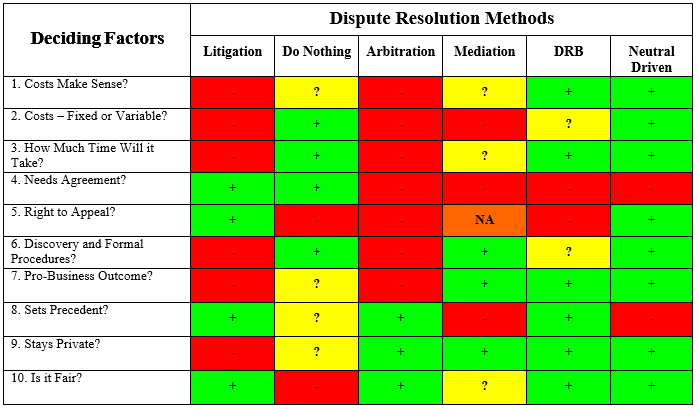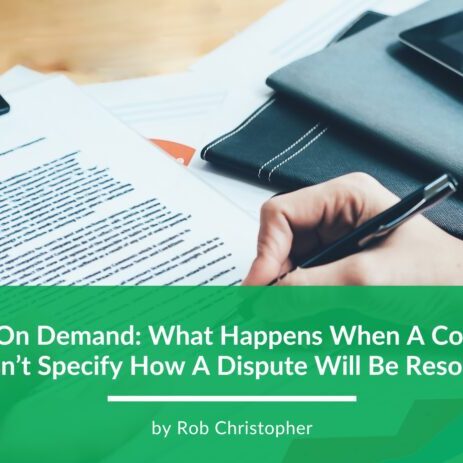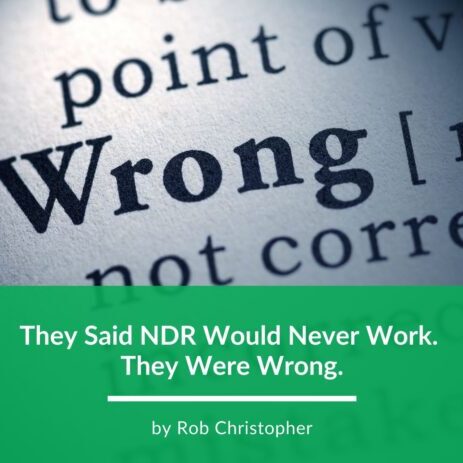Runaway Costs and Domino Delays: Innovative Ways to Resolve Subcontractor Disputes

Deciding Factors in Choosing a Dispute Resolution Method, And Why It Matters
Whenever a disagreement can’t be settled in a couple conversations, it may become necessary to choose a dispute resolution method to resolve such disagreement. Consequently, you should know a few things about the available dispute resolution methods. First, you should know your options – currently there are at least six basic methods (see the accompanying table), and second, you should know when it makes sense to use each method. We at Just Resolve have identified ten factors worth considering when choosing a dispute resolution method and assigned a positive or negative value to each factor. We have also listed a question mark when a factor could go either way depending on the particular circumstances.
The identified decision making factors (Deciding Factors) are:
1. Costs Make Sense: Do the total costs of the dispute resolution process make sense for what is at stake? If not, that factor is negative for that process, and it may even be a show-stopper right out of the gate. For example, there’s no justice and usually no sense in spending $90,000 or more on a $100,000 dispute. And if you include in total costs – as you should – ALL costs including legal fees, expert fees, neutral/judge fees, and ball-park estimates of hidden costs due to delay, distraction, risks to reputation and relationships, and stress, the total costs per party can quickly become disproportionate to what is at stake in most common, everyday disputes.
2. Costs – Fixed or Variable: Are the costs fixed or capped and therefore cash-flow friendly and manageable? The more fixed or determined the costs are, the more positive this factor is. Or are the costs variable, open-ended, or unpredictable? The latter are plainly a negative.
3. Right to Appeal: If the process culminates in a decision and that decision is plainly biased or grossly wrong, can you appeal the decision to a higher authority, or are you stuck with it?
4. Needs Agreement: Do you need an agreement to use this method or can one party unilaterally decide to use this method? If you need prior agreement to use a method, that’s an inherent disadvantage and barrier to using that method. Arbitration and other binding alternative dispute resolution (“ADR”) methods are best agreed to contractually at the outset of a relationship. It is much easier for parties to agree to a method then rather than later when a dispute has arisen and they may have difficulty even agreeing on the color of the sky.
5. Time to Resolution: How much time does it take to resolve a dispute? The longer it takes to resolve a dispute, the more opportunity there is for maneuvering, mischief, and unnecessary burdens, and the greater the likelihood of irreversible direct or collateral injury to the parties’ businesses.
6. Discovery and Formal Procedures: Does the process rely on adversarial (and often-abused) methods of investigating the facts and sorting out procedural issues – like time-consuming and expensive depositions, broad records requests, competing written interrogatories, and extensive legal briefs and hearings to resolve disputes about them and other procedural issues? We have made a value judgment from a business perspective that the burdens and distractions of these procedures are negatives for the methods, which rely on them, because there are other, more collaborative ways to investigate the essential facts of a case. On the other hand, many attorneys argue that these procedures are important and necessary to protect each party’s rights and ability to uncover the complete truth.
7. Pro-Business Outcome: Does the chosen process tend to further polarize the parties, for example by provoking strong egos and inflaming emotions, or does it tend to promote collaboration and partnering? The ultimate goal of any resolution method is to institute the fairest solution possible and some methods are more likely to produce a continuing business relationship between the parties. The more collaborative the approach, the more positive the factor is.
8. Sets Precedent: Does the chosen method set a precedent of conduct or behavior between the parties that will guide or determine similar future disputes between them or others? If the outcome of this dispute will alter the behavior of this party or others, then it sets a precedent.
9. Stays Private: Does the method tend to keep the dispute’s course and outcome private, or does it subject the parties to uncontrolled public exposure and scrutiny? By making the process or resolution public, the party is indicating how it will choose to respond to similar disputes in the future.
10. Is it Fair: Is the process itself fair and likely to lead to a just result? Is this fairness equation changed if one party has much greater economic power and is willing to use it to outspend or intimidate the other?
Using these factors, we can look at most common dispute resolution methods and see how they stack up against one another.
Litigation – Litigation (going to court) is the default when parties cannot agree to an alternative, and may be the right choice if you want your case to be heard in front of a jury, you need to set a clear precedent, or you have a bet-the-company or other very high stakes case. These situations arise when it is worth whatever cost and time is required to know that you have enjoyed every possible right and done all in your power to prevail. From a cynical viewpoint, litigation can also be the tool of choice when a party is able and willing to play the 800-lb. gorilla, though that strategy has its perils and can easily backfire in the face of a determined opponent. Otherwise, avoid litigation because the likely total costs, risks of runaway expense or liability, and long time to resolution disfavor it, especially in common everyday disputes where the time and money spent will almost always quickly eclipse what is at stake.
Do Nothing – This strategy is self-explanatory, admit when you’re wrong and do the right thing as a general policy. It’s good for business both in the short and long term. Doing nothing may also take the form of foregoing your own valid claim or caving in to another’s extortion. Do this only if you know you can “make it up” on another deal, the costs of asserting your rights will exceed what’s at stake, and you won’t be setting a dangerous precedent as an easy mark. Otherwise, choose (in advance of any disagreement if possible) a method that will enable you to stand on your principles without wasting more time and money than the dispute is worth.
Arbitration – In general, you should usually choose arbitration (private judging without juries or appeals) over litigation if you are concerned with reducing the risks of potential class actions or public disclosure, or to avoid juries – who are seldom composed of business peers. In practice, however, the arbitration process and rules have become so “lawyerized” that arbitration often ends up being as expensive, open-ended, and time-consuming as litigation, without the safeguard of being able to appeal a patently wrong award or decision. A better solution may be to specify arbitration as the default path for any disputes that can’t be resolved through a more economically rational process like one or more of those below.
Mediation – Use mediation (a neutrally facilitated settlement negotiation) if you think neutral diplomacy will lead to a viable compromise, for example when the parties are close to reaching an agreement but need a little extra push, or when one or both parties need a dose of reality. Mediation does not make sense if one party has no incentive to settle or is likely to use the process to delay or as a weapon to drive up everyone’s costs. Know that mediation can require multiple sessions and, when it fails, it can add substantially to the costs of any dispute.
Dispute Resolution Board (DRB) – This dispute resolution method was specifically designed to anticipate and resolve time-sensitive disputes in large construction projects. Using a DRB requires the parties to retain and pay a board of neutral experts who monitor a project so that they can investigate and advise quickly on (or decide, if so agreed) disputes that may arise. The process is non-adversarial in the sense that the DRB, and not opposing teams of lawyers, conduct the investigation with the required cooperation of the parties. The DRB method should be used in conditions like those described above where the contract or project is large enough to warrant the cover charge. Do not use a DRB in relationships where disputes are unlikely, the expertise likely to be needed is unpredictable, or the costs of the DRB’s monitoring will approach or exceed likely stakes in dispute.
Neutral Driven – The Neutral Driven process combines select elements from every method above. It is most easily agreed at the outset of a relationship and relies on one or more private arbiters chosen by the parties to pro-actively and collaboratively investigate a dispute before recommending or deciding an outcome. A neutral driven resolve is provided for a fixed fee that is a guaranteed fraction of the stakes and is split between the parties. If agreed, the method can include mediation and/or an appeal. A neutral driven method is best used in common disputes whenever the total costs of using another method will approach or exceed what is at stake, or any time a quick and fair resolution is critical. It shouldn’t be used to decide issues of public policy, complex matters, or bet the company cases.
As you can see from all of these different dispute resolution methods, there are many strategic considerations to weigh before choosing a particular method. Both ignoring one’s choices and blindly agreeing to a particular method without due consideration may lead you down an expensive and perilous path. In a world where time is precious and each point of margin makes a real difference to your bottom line, having a pro-active and considered approach is well worth the while of any business today.
More to read
NDR on Demand: What Happens When a Contract Doesn’t Specify How a Dispute Will Be Resolved?
The best way to deter threats of litigation and minimize the costs, duration, and distractions of resolving any dispute is to put a dispute resolution clause specifying NDR — Neutral-Driven Resolution — in all your contracts BEFORE there is a problem. That means that if a dispute should arise between a business and a contractor,…
They Said NDR Would Never Work. They Were Wrong.
Many people are surprised by how effective NDR can be. Since publishing my book and speaking at events about NDR (Neutral-Driven Resolution), I’ve often been asked a simple question: Does it work? And if it really does lower the costs and the time it takes to settle common disputes, why doesn’t everybody know about…
“Morgan Hill author releases new book”
The Morgan Hill Times featured Rob’s new book in an article ahead of his “Meet the Author” night at Booksmart. “Legal disputes and conflicts cost businesses billions of dollars a year in lawyers’ fees, lost productivity, time and aggravation. A new book by Morgan Hill author Robert Christopher proposes an innovative, faster and simpler way…
Not All Disputes are Equal
Not all business and legal disputes are alike, and not all of them can be resolved in the same way. In writing my book Just Right: How Neutral-Driven Resolution Can Close the Gap in American Civil Justice, it was important to distinguish the types of common disputes for which NDR is most suitable. As readers…



